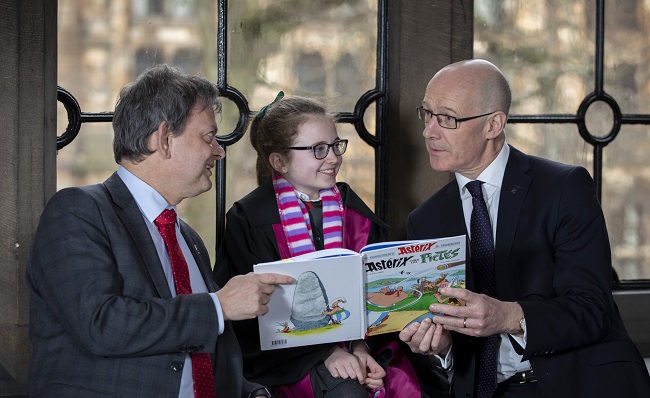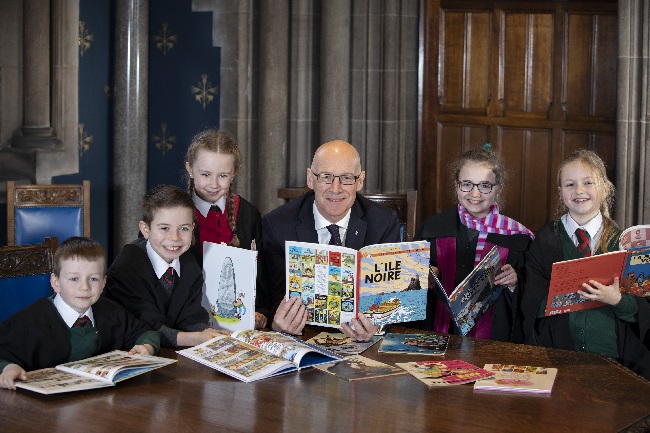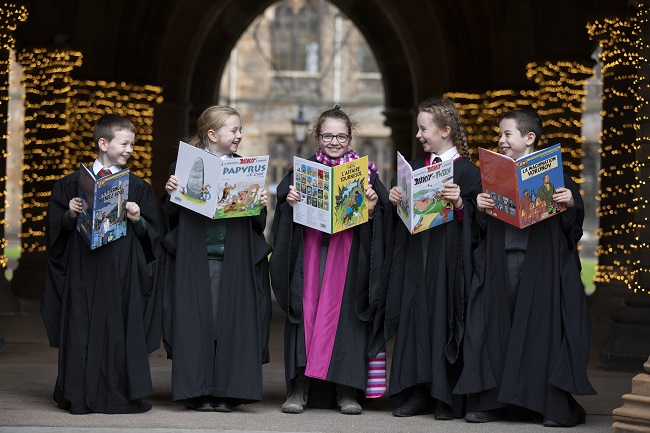University of Glasgow research used to create new resources for primary and secondary pupils
Published: 21 January 2019
The University of Glasgow and Education Scotland officially launched a range of online teaching resources from academic research tailored to the needs of Scottish pupils.
 UofG's Professor Sir Anton Muscatelli, St Patrick's Primary pupil Paige Brown and Deputy First Minister John Swinney with a French language comic which is part of the new online education resources
UofG's Professor Sir Anton Muscatelli, St Patrick's Primary pupil Paige Brown and Deputy First Minister John Swinney with a French language comic which is part of the new online education resources
The University of Glasgow and Education Scotland officially launched a range of online teaching resources from academic research tailored to the needs of Scottish pupils.
A total of 12 resources using University research have been specially created by teachers for the Curriculum for Excellence to use in Broad General Education, which covers nursery to S3.
The resources, based on the latest scholarship in Arts and Humanities at the University, cover a diverse range of topics from French comics to archaeology, political songs to medieval history, Polish films to Scots language.
The project takes full advantage of the Curriculum for Excellence which allows for more flexibility in its content as BGE is based primarily on ‘experiences & outcomes’.
This structure means that diverse subject areas – such as those researched at universities – can now be taught in the classroom.
The project was officially launched by Deputy First Minister John Swinney at the University of Glasgow and was also attended by teachers, pupils and academics involved in this innovative project.
Deputy First Minister John Swinney said: “These resources deliver a diverse range of topics – many of which are unique in a classroom setting - to learners from age three to 15 in an engaging and exciting way.
“They support teachers and other practitioners by providing them access to current academic research for use in their own practice and they promote the flexibility that is so central to our Curriculum for Excellence.
“I thank the University of Glasgow and Education Scotland, whose strong collaboration was instrumental in the project’s success.”
 Deputy First Minister John Swinney and pupils from St Patrick's Primary School, Shotts at University of Glasgow
Deputy First Minister John Swinney and pupils from St Patrick's Primary School, Shotts at University of Glasgow
The collaboration, which started as a pilot in 2014, is run by Professor Dauvit Broun and Dr Joanna Tucker (University of Glasgow) and Lynne Robertson (Education Scotland).
Professor Broun, Director of the University’s ArtsLab which supports research-led activities in the College of Arts, said: The strength of this scheme is that it allows us researchers to work with schools in a way that is truly collaborative, and produces resources which speak directly to the needs of those actually working in the classroom.
“Working with school teachers has been extremely rewarding, since they approach the subjects in such a creative and open way, which challenges us researchers to rethink our own work.
“When designing this scheme, it was fundamental that the teachers be in the driving seat, steering what the resources would look like, since they have the real experience of what works in the classroom.
“We are delighted that the teachers and academics involved in these collaborations have produced original, creative and useful resources which can be used by any teacher in Scotland.”
Dr Tucker, Arts & Humanities Innovation Researcher, said: “As University researchers, our work does not always ‘fit’ directly with the subjects taught and examined in the National Qualifications.
“The advantage of Broad General Education is that it is flexible in its content, and so the topics we research can now be useful in schools.
“This is the beginning of a new era in how universities and schools work together. The scheme demonstrates the common purpose of learning, regardless of whether it is in a primary classroom or a lecture theatre. It is about bringing together the results of advanced research and the creativity & experience of teachers in partnerships that boost the value of each for the benefit of all.”
The resources are Quality Assured and published by Education Scotland to support learning across the whole curriculum.
Lynne Robertson, Senior Education Officer at Education Scotland, said: “It has been a real privilege to jointly co-ordinate this project with the University of Glasgow.
“This innovative and exciting collaboration between teachers and academic staff has ensured that what works in schools has been incorporated in this suite of high quality, original and informative resources. These will be able to be used easily and effectively in the classroom across Broad General Education.”
The resources all take different forms, but generally consist of materials such as lesson plans, PowerPoints, workbooks for pupils, edited texts, audio files, videos, or selected images.
The scheme is funded by the University’s ArtsLab (which supports research-led activities in the College of Arts). ArtsLab pays for the teachers’ time. Education Scotland provide support for the scheme by recruiting teachers and curating the resources online.
 Pupils from St Patrick's Primary School, Shotts in the Cloisters at the University of Glasgow
Pupils from St Patrick's Primary School, Shotts in the Cloisters at the University of Glasgow
The full list of resources available on the National Improvement Hub, include:
1. People of Medieval Scotland
This resource focuses on different aspects of medieval Scotland, including names, battles, languages, money, maps, weapons and government.
2. Astérix chez les Pictes: Using Comics to Teach French
This resource uses the Astérix comics to teach French language and culture.
3. Gwiazda Kopernika (‘The Star of Copernicus’): Learning Polish Through Film
This resource uses a film to teach Polish language, culture and history, with a particular focus on the astronomer Nicolaus Copernicus.
4. Words for Weather in Scots
This resource highlights the different Scots words for types of weather, focusing in particular on words for ‘snow’.
5. Scotland in the world: How others see us in film
This resource explores how Scotland is portrayed in films, using three particular examples of Brigadoon (1954), Loch Ness (1996) and The Da Vinci Code (2006).
6. History of Weather
This resource explores how weather is recorded, both now and in the past.
7. Prehistoric Monuments in Urban Contexts
This resource explores how prehistoric monuments can be used to understand Scottish prehistoric life, but also how society values and protects our heritage.
8. Computer Games & Storytelling
This resource looks at how computer games use storytelling, in particular looking at the concept of the hero’s journey narrative in computer games.
9. Vikings in Scotland
This resource looks at how the Vikings lived in Scotland, including their burials and clothing.
10. Alfred Nobel and the Peace Prize
This resource explores the history of the Nobel Peace Prize, some of its prominent winners, and the links to Scotland through the founder, Arthur Nobel.
11. Scottish Political Poetry & Song 1832–1918
This resource uses a set of recently collected poems and songs to explore political issues of the day across Scotland (such as voting rights and the Suffragettes).
12. Homes in High Places: Urban Life in 20th-century Scotland
This resource explores life and play in urban Scotland, particularly focusing on the experiences of living in tenements and high rise flats.
First published: 21 January 2019
<< January

